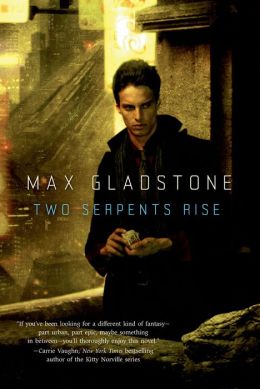Max Gladstone’s Two Serpents Rise, is his second book in the Craft sequence and falls chronologically before his first book, Three Parts Dead. His first novel took place in Alt Coulomb, a city where at least one god is alive and when and living on the faith of his worshippers. The new novel, set in Dresediel Lex, is in a city where the gods have been replaced by something a good deal more industrial.
Before the Dresediel Lex’s gods had their place usurped, they were of the feathered serpents, sustained by sacrificed hearts on the top of pyramids variety. The novel’s protaganist, Caleb, is the son of the last high priest of their order, who is now an insurgent leading a rump caucus of worshippers. Caleb, meanwhile, works for the organization that supplanted his father and his father’s faith. Red King Consolidated uses Craft (magic powered by human souls — a fraction of your own or somebody else’s) to run the city.
The story is largely about the tension between the old ways and the new, and also a romance, a conspiracy, and some particularly horrifying demons. But it’s mostly a story about relationships and sacrifice. Craft is transactional, to do magic, something always changes hands. Think of it as being like, at minimum, the dollar that has to be paid to make a sales contract real.
But sacrifices are given freely, without thought of recompense. Only some of the temple sacrifices under the old system were volunteers, but partisans of the old system say at least their sacrifices were felt as loss and were visible. The new masters of Dresediel Lex have democratized sacrifice, and any drain on souls is more at the level of taxation in our world – a small to moderate inconvenience, but not painful. Is it worse to be hurt so slowly and lengthily that you can’t feel the ache? Is there something more sublime about making payment into sacrifice, instead of mere debt, and enshrining it in ritual?
In our world, the closest analogy I can come up with is monks, friars, nuns, and sisters. These are people wholly consecrated to religious life, whose devotion we cannot ignore. For many orders, their habits mark them out as set apart, when we run into them on the street. Of course, some cloistered nuns or monastics are nearly invisible to us, turning their lives over to prayer but separated from the world they pray for. How do we stay conscious of their work, and remain startled by its intensity? How do we keep manageable sacrifices and gifts of ourselves from feeling humdrum and dull?
I received a free copy of this book for review. You can read parts one and two of my interview with the author, Max Gladstone, at the links. He’s also done another interview with Alyssa Rosenberg of ThinkProgress, which I heartily recommend. And you can follow Max on his own blog here.













